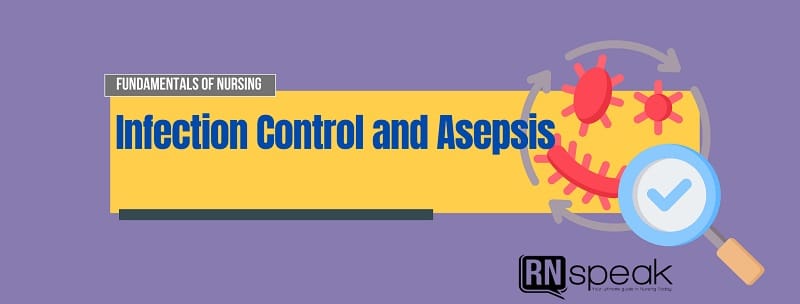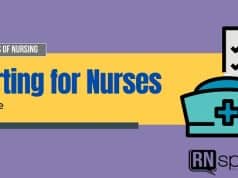Microorganisms, whether we like it or not, are present everywhere even in areas we can’t set our eyes upon. It is present in the water we drink, in the things we use even in our body surfaces, in our mouth, intestines and evidently in our skin. There are a number of these microorganisms that are harmless and are even most often beneficial to our bodies as they perform some essential functions. But some microorganisms are most likely known because of their potential to cause a disease.
The following are terms that you need to understand to easily grasp the concept of infection control and asepsis
- Infection occurs when a certain microorganism invades and proliferates in body tissue and the microorganism is called an infectious agent.
- Disease occurs when there is a significant and detectable alteration in normal tissue.
- Communicable disease occurs when the infectious agent can be transferred to a person by direct or indirect contact, airborne or through a vector.
- Pathogenicity is the ability of the microorganism to produce a disease.
- Virulence is the extent of pathogenicity of the invading microorganism. It is measured by the extent to which it damages tissues as well as the intensity of the disease produced.
- Opportunistic pathogens only cause a disease when the individual is susceptible or immunocompromised.
- Asepsis is a state wherein there is no presence of disease-causing microorganisms
- Medical Asepsis or clean technique are a number of practices done to contain a specific microorganism to a limited area, reduce their number, controlling their growth and prevent the transfer of the microorganisms. Objects are seen as clean in medical asepsis which is probably free from almost all microorganisms and dirty or soiled if the object is likely to have any microorganisms in it.
- Surgical Asepsis or sterile technique is a set of practices used to maintain an area or object free from any microorganism which includes spores and viruses.
- Nosocomial infections are infections that mainly occur through the delivery of health care services in a health facility such as the hospital. This type of infection is what we are most concerned about as nurses because this is what we don’t want to happen to our clients while they are admitted in the hospital.
There are six links that make up the chain of infection and all these interplays with each other and must be present to be able to initiate an infection
First
The element of the cycle is the etiologic agent which is basically the term denoting to the offending microorganism.
The reservoir is the source of where the organism originated and it can be from other humans, the client’s own organisms, animals, plants or from anywhere in the environment.
Third
The portal of exit from the reservoir, the offending organism must first exit the reservoir to be able to establish itself in a host.
Fourth
The offending microorganisms after exiting from the reservoir will try to reach a host through an entry point.
Fifth
The portal of entry to the susceptible host, before the host will be infected it must first enter the body of the host via an entry point.
Sixth
And lastly, the sixth element of the chain is the susceptible host, is any person who is at risk of infection due to impaired natural defenses of the body.
To combat the spread of infection and to maintain asepsis here are some ways to do it
- Handwashing is an indispensable and effective infection control measure. Handwashing is very important and is most of use in hospitals especially in dealing with the prevention of nosocomial infections. A client can have a number of microorganisms that are harmless to him but may be harmful to other clients once it is transmitted.
- Cleaning will prevent the proliferation of microorganisms by removing dust or soil or any organic material from objects. Disinfecting is the removal of harmful microorganisms except for the spores and it can be through a chemical solution like phenol or iodine compounds. Sterilizing is a more comprehensive process of eliminating microorganisms because it doesn’t only destroy those microorganisms throughout the process but also includes the spores and viruses. There are four methods of sterilization that are most used and these are gas, moist heat, radiation, and boiling water.
- Isolation precautions are measures used to be able to decrease transmission if not to totally prevent the spread of infection or any potential infectious microorganism to clients, visitors, and health personnel.
- Personal protective equipment such as clean or sterile gloves, masks, gowns, and protective eyewear is worn when a person is exposed to potentially infected materials.
- Sterile techniques are a set of practices used with the aim of minimizing if not preventing the contamination by pathogens usually when doing certain procedures.
Nurses as healthcare providers should know about the methods of asepsis and infection control to be able to provide clients with a safe environment. A safe environment that means providing an environment with minimized risk if not prevent any possible infection. It is imperative that the client’s environment should be biologically safe since we function to promote the client’s health, prevent any further illness or complication, and paving a way to a smooth journey to recovery.
References
- Bernas, A., Snyder, S., & Kozier, B. (2007). Kozier and Erb’s: Fundamentals of Nursing Concepts, process and practice. (8th Ed.) New Jersey: Prentice Hall. Gladys Xavier. (1999).
- Asepsis. Royal College of Nursing. Retrieved: May 23, 2012. http://nursingstandard.rcnpublishing.co.uk/archive/article-asepsis













